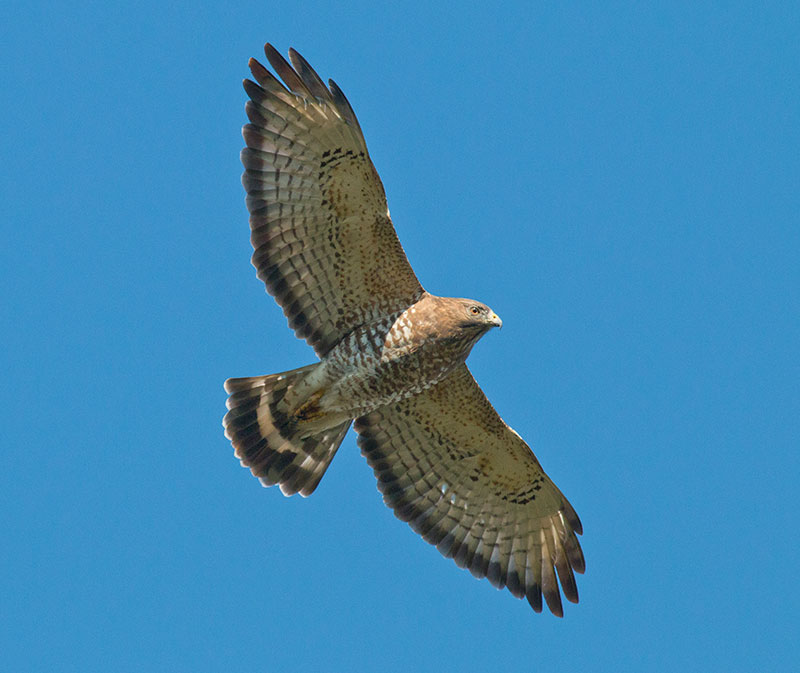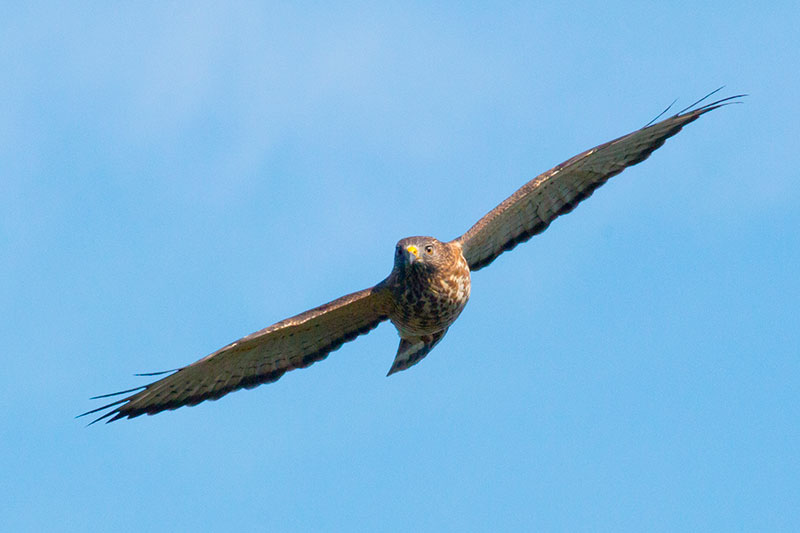Guide to Fall Hawk Watching
9/6/15
By David Brown
Imagine sitting on top of a mountain and having hundreds of hawks circling above you. Picture sitting under a decoy owl as a falcon dives at it. These are real situations that you can experience in Pennsylvania this time of year.
These are my tips for beginners who want to try out hawk watching. Hawk watching involves going on top of a mountain and using a pair of binoculars to spot and identify migrating raptors such as hawks, eagles, and falcons. September is a great month for beginners because the weather is mild and broad-winged hawks reach their migration peak as they rush to central and South America for the winter. On a good day in mid-September hundreds, or even thousands, of broad-winged hawks can be seen, often migrating in large groups called kettles.

Broad-winged Hawk
I recommend starting out at a hawk watch with official counters. The north lookout at Hawk Mountain Sanctuary located along the border of Berks and Schuylkill Counties is probably the most friendly towards beginners, but has a small entrance fee and requires a mile hike to get up to. I went to Hawk Mountain last September 15th and saw nearly 900 broad-winged hawks and almost 100 individuals of 11 other raptor species. Waggoner's Gap Hawk Watch near Carlisle is a free hawk watch run by Pennsylvania Audubon that requires only a short hike. Other fall hawk watches in the state include Bake Oven Knob, Second Mountain, and Allegheny Front.
Bring a pair of binoculars, a cooler with food and drinks, sunscreen, a hat, sunglasses, and a cushion to sit on. Some hawk watches may have room for chairs but at most of them everyone just sits on rocks. When you get to the hawk watch it is good manners to say a brief hello to the counters, especially if there is only a small crowd. After that, pick out a free spot to sit. I always prefer to stay within earshot of the counters to hear the birds that are called out. The counters will keep track of the number of each species that migrates past and for certain species will also make note of the age, sex, and time for each bird. The birds are usually fairly far away, so someone expecting amazing views may be disappointed. However, many hawk watches have decoy owls to bring the birds in closer and seeing a hawk or falcon dive at the owl is something you will never forget.

Broad-winged Hawk
I recommend getting to the hawk watch as early as possible, ideally before 9am. Early migrants are often lower because the thermals have not built yet. Also, in late morning and early afternoon there is often a lull, and I have seen many people arrive at the hawk watch and only stay during this time and leave thinking it was not a good day. Plan to stay at least a few hours to have a good chance of seeing some bursts of activity. If the flight is good the counters may stay until the early evening.
Hawk watching has a team atmosphere and even beginners can help out spot birds, even if they can't identify them. Like most types of birding, it is just an excuse to get out and enjoy the excitement of nature with others, so give it a try at least once and you may find yourself drawn back to the mountain each fall.